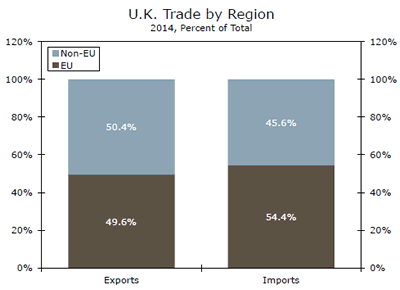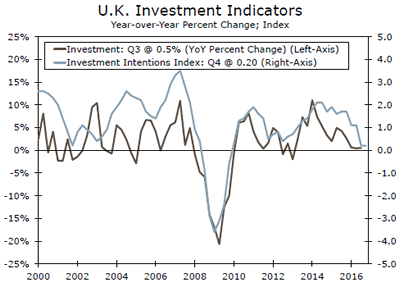U.S. Review
Trading Places
- Real GDP growth slowed in Q4 to a 1.9 percent annualized rate. After providing a sizable boost to economic growth in Q3, net exports exerted a significant drag on growth in Q4. Business fixed investment continued its gradual recovery.
- Full-year real GDP growth was 1.6 percent in 2016, matching the slowest annual pace since the recovery began. We expect real GDP to accelerate to a 2.3 percent pace in 2017, buoyed by a more a balanced composition of growth.
- Existing and new home sales for December were weaker than expected, with a sharp dip for new home sales as higher mortgage rates weighed on sales activity.
Real GDP Growth Slows to End 2016
Real GDP growth in the United States slowed to end the year, registering a 1.9 percent annualized growth rate in Q4. International trade weighed heavily on economic growth in Q4, largely as a result of some payback due to the quirky surge in soybean exports that boosted growth in Q3. Real final sales to domestic purchasers, which exclude trade and the volatile inventory component, actually accelerated in Q4 to a 2.5 percent pace (top chart). This measure of underlying domestic demand had slowed over the past year and a half or so, but recent data suggest some firming, which we anticipate will continue in 2017.
Within the sectors of the economy, personal consumption decelerated but remained solid at 2.5 percent, while business fixed investment increased at the fastest pace in more than a year (middle chart). A 3.1 percent annualized gain in real equipment spending halted the string of four straight quarterly declines in equipment capex. This spate of poor capex readings was unusual for a non-recessionary period, and the growth registered in Q4 is a welcome sign that business fixed investment has some modest momentum to start the new year. Residential investment also bounced back, increasing at a 10.2 percent annualized rate after two consecutive quarterly contractions. Government consumption and investment continued to plod along, rising at a 1.2 percent pace led by state and local governments.
Full-year real GDP growth was 1.6 percent in 2016, matching 2011 for the slowest year of growth in the recovery. The sources of growth were rather uneven, with a solid domestic consumer but weak business spending. Real business fixed investment declined 0.4 percent in full-year 2016, the first outright contraction since 2009. The inventory drawdown that played out over 2016 also exerted the largest annual drag on economic growth from this sector since the recession. There are signs, however, that these sources of weakness have begun to see a reversal of fortunes. Oil prices have rebounded from their 2016 lows, and we expect a gradual appreciation from current levels, which should further reduce the energy drag on capital spending. Inventories have added to growth in two consecutive quarters for the first time in nearly two years and should play a more neutral role on growth in 2017. We expect real GDP to accelerate to a 2.3 percent pace in 2017 amid a more a balanced composition of economic growth.
Other than this morning’s GDP print, it was a light economic data week in the United States. Existing and new home sales for December were weaker than expected, with an especially sharp dip for new home sales. The new home sales report was the first chance to assess the effect of higher mortgage rates. Existing home sales measure closings and reflect mortgage rates from sales contracts signed a month or two earlier. Despite the 10.4 percent decline in new home sales in December, sales rose a solid 12.2 percent in full-year 2016 and continued their gradual improvement from the housing bust (bottom chart). We expect home sales to rise slowly in the first half of 2017, as consumers adjust to higher interest rates and look for continued improvement in sales over the course of the year.
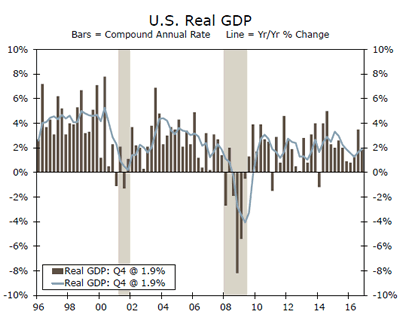
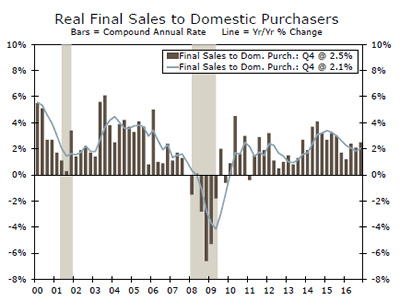
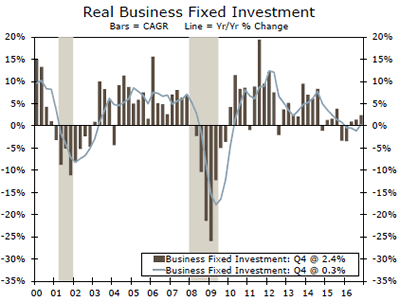

U.S. Outlook
Personal Income & Spending • Monday
The November personal income and spending release painted a disappointing picture for consumer activity over the month. Nominal personal income came in flat, as growth was largely held back by a 0.1 percent decline in wages and salaries. Despite easing in the savings rate, nominal spending was also weak, rising just 0.2 percent. We expect November’s income stall was temporary and look for stronger readings for personal income and spending in December, rising 0.4 percent and 0.3 percent, respectively.
The core PCE deflator, the Fed’s preferred measure of inflation, came in flat in November, pulling the year-over-year rate down to 1.6 percent. We expect prices to recoup these losses in December, and edge up to a 1.8 percent year-over-year pace. Looking ahead, we expect further upward pressure on consumer prices in 2017, with the PCE deflator rising 2.0 percent year over year compared to an estimated 1.1 percent in 2016.
Previous: 0.1% (Income) Wells Fargo: 0.4% Consensus: 0.4%
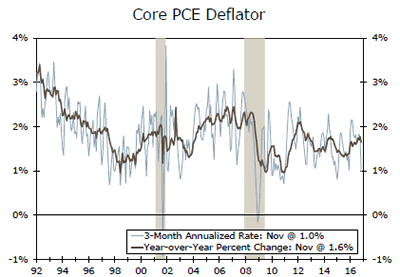
ISM Manufacturing • Wednesday
U.S. manufacturing activity ended 2016 on a strong note with the ISM manufacturing index rising to a two-year high of 54.7 in December. This barometer for the factory sector has improved significantly relative to a year ago when weakening global growth, collapsing commodity prices and a strengthening dollar led to outright contraction in the sector.
Production and new orders surged in December, each rising above 60. The pickup in new orders signals that, in the near term, momentum in manufacturing looks set to continue. More manufacturers reported hiring additional employees in December, as the employment index rose to an 18-month high on the month. The positive trend in the ISM employment index coincided with a 17,000 gain in manufacturing payrolls—the first positive addition since July. We expect further stabilization in the factory sector, and look for the index to hold its recent gains in January.
Previous: 54.7 Wells Fargo: 54.8 Consensus: 55.0
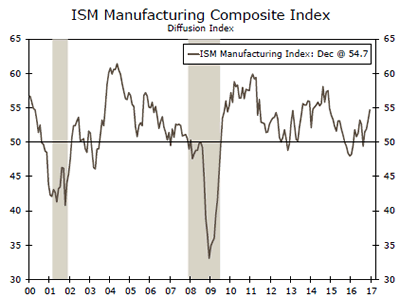
Employment • Friday
Payrolls increased by 156,000 jobs in December, pulling average monthly job growth for 2016 down to 180,000. The pace of hiring has slowed over the past two years, as tightening labor market conditions limit job gains. The unemployment rate edged up, capping the year at 4.7 percent, but remains consistent with full employment. Average hourly earnings jumped 0.4 percent higher in December, bringing the year-over-year rate to a cycle high of 2.9 percent. Taken together, the pickup in earnings and slowdown in job growth are consistent with reports of a tightening labor market and employers having difficulty finding qualified workers.
Next week’s release will likely draw heightened attention, given that it will be the first employment report of the new year and the first report of the Trump administration. Our forecast calls for a gradual easing of trend job growth in 2017; however, we still expect growth to be strong enough to pull the jobless rate lower over the year.
Previous: 156,000 Wells Fargo: 155,000 Consensus: 175,000
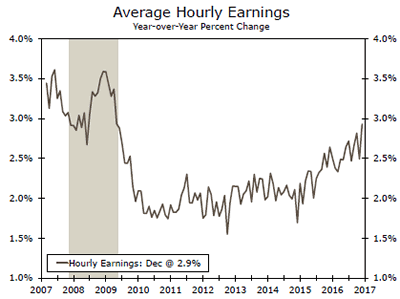
Global Review
Stronger-than-Expected U.K. GDP Growth in Q4
- Recent data continue to show that the U.K. economy remains resilient seven months after the Brexit referendum last June. That said, lingering uncertainties regarding the economic outlook probably mean that a rate hike by the Bank of England (BoE) is not on the docket in the near term.
Uncertainty Clouds Mexican Economic Outlook
- Economic activity in Mexico accelerated in November. However, much of the apparent acceleration was attributable to the inherently volatile agricultural sector. Recent monetary tightening by the Bank of Mexico and uncertainties related to the status of NAFTA cloud the Mexican economic outlook.
Stronger-than-Expected U.K. GDP Growth in Q4
Data released this week showed that real GDP in the United Kingdom grew 0.6 percent (2.4 percent at an annualized rate) on a sequential basis in Q4-2016 (see chart on front page). The outturn was stronger than most analysts had expected, Moreover, the British economy has shown few ill effects from the surprising Brexit referendum last June, at least not through Q4. The resilience in the economy in recent quarters is leading to a change in the inflation dynamics in the United Kingdom. The overall CPI inflation rate rose to its highest rate in more than two years in December, and the core rate of inflation has been creeping higher in recent months (top chart). Everything else equal, the Bank of England may be induced to tighten policy in the near term.
As we describe in more detail in a recent report, however, everything else is not necessarily equal. (See U.K. Q4 GDP Growth: BoE Policy Implications?, which is posted on our website.) Growth in real retail spending lost some momentum in Q4, and the upcoming negotiations with the EU over the terms of the U.K.-EU divorce could still weigh on investment spending (see Topic of the Week on page 7). Although a rate hike by the BoE does not look likely in the near term, we acknowledge that monetary tightening could happen this year if the economy remains resilient.
Uncertainty Clouds Mexican Economic Outlook
Like the United Kingdom, Mexico is an economy that has its economic outlook clouded by recent political developments. Namely, the potential for re-negotiation of the NAFTA agreement that the Trump administration is seeking adds downside risk to the Mexican economic outlook. That said, data released this week showed that Mexican economic activity accelerated in November. Specifically, the economic activity index, which is a good proxy for GDP growth, rose 3.7 percent on a year-ago basis in November, up significantly from the 1.3 percent rate registered in October (middle chart).
However, there is less than meets the eye to the economic activity data in November. For starters, most of the acceleration came from the inherently volatile agricultural sector. The more important industrial sector showed no acceleration between October and November. In addition, the data are from November, so the surprise from the U.S. presidential election probably has yet to be fully captured in the economic data.
In that regard, the Mexican peso depreciated more than 15 percent against the U.S. dollar between Election Day and Inauguration Day. The CPI inflation rate in Mexico rose to 3.4 percent in December from 2.5 percent in June, and the depreciation of the peso puts further upward pressure on inflation. Due to rising inflation expectations, the Bank of Mexico has hiked its main policy rate 275 bps since December 2015 (bottom chart). Rising interest rates could choke off investment spending, thereby leading to slower GDP growth. Indeed, we believe that the combination of rising interest rates and uncertainty related to NAFTA will lead to a mild recession in the Mexican economy this year.
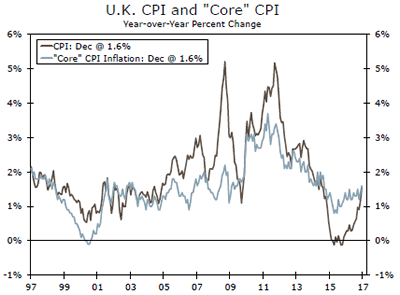
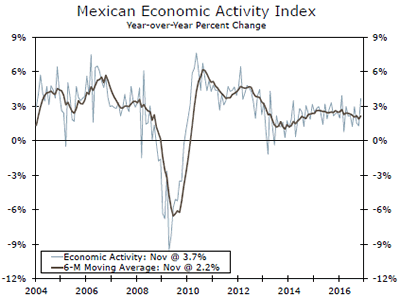
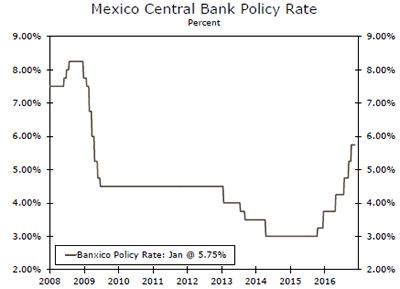
Global Outlook
Chinese PMIs • Tuesday
The official Chinese manufacturing PMI, which is slated to be released on Tuesday, has expanded for the fifth consecutive month printing at 51.4 in December, down from 51.7 the month prior. A reading above the 50-threshold signifies that the sector is expanding, while a below-50 reading indicates a contraction. The weaker reading was due to sluggish factory output and a decline in new export orders and jobs. Markets are expecting the index to have declined a touch in January to 51.2 as the Chinese government has started to rein in rapid growth in residential investment.
Additional data on the docket to be released next week include the Caixin manufacturing PMI, which is considered as a private gauge of manufacturing activity. The index climbed to 51.9 in December from 50.9 in November—beating market expectations and remaining in expansion territory. That said, the consensus expects the index to have declined in January as well.
Previous: 51.4 Consensus: 51.2
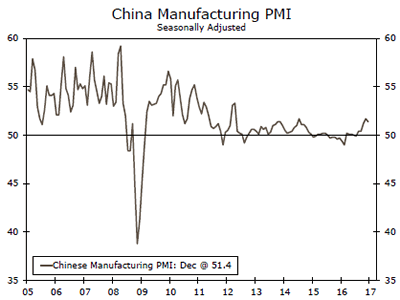
Mexico GDP • Tuesday
The Mexican economy grew at a 4.0 percent annualized rate in Q3 2016—its fastest pace in more than two years. Much of the growth came from strong performance in the manufacturing sector, which has become a notable bright spot in the economy. The mining and construction sectors, however, weighed on growth. On a year-ago basis, the economy was up a more modest 2 percent, still beating market expectations of 1.9 percent.
Earlier this week, Mexico’s Economic Activity Index, which is highly correlated with overall GDP growth, showed that the economy had grown by 3.7 percent in November, on a year-ago, non-seasonally adjusted basis, driven by a surge in the primary sector, which is quite volatile. As such, we look for the Mexican economy to have expanded by a slower 1.8 percent year-over-year pace in Q4, as slowing fundamentals and rising interest rates and inflation point to weaker growth.
Previous: 2.0% Wells Fargo: 1.8%
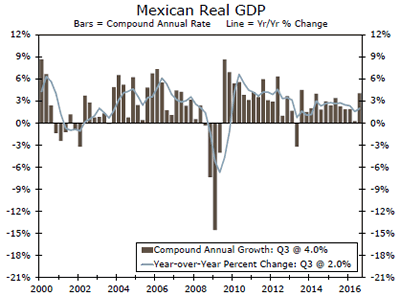
Brazil Industrial Production • Wednesday
On Wednesday, Brazil will release its industrial production index (IP) for December as markets look for some sort of a recovery. The Brazilian industrial sector rose 0.2 percent in November compared to the month prior, but is still 1.1 percent lower than its year-ago reading. The industrial sector was helped by an increase in its mining/extractive activities component, which is up 4.5 percent year over year. The all-important automobile production sector also saw a notable increase in growth, up 13.4 percent year to year. It is clear that the Brazilian industrial sector has hit bottom and is poised to recover during the next several quarters. However, the main concern, now, will be the speed and strength of the recovery.
Additional data slated to be released next week include the Brazilian manufacturing PMI, which closely follows activity in the factory sector. In December, the index slipped further below the 50-demarcation line to 45.2, signaling contraction in this sector.
Previous: -1.1% Consensus: 0.6% (Year-over-Year)
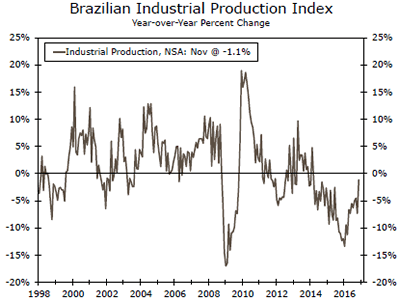
Point of View
Interest Rate Watch
Anticipating the Promised Change
Past good results are no guarantee of future success—nor are disappointing results. The Trump administration has promised to improve growth and this represents an intellectual challenge to market estimates of the future.
More Growth: Three Is the New Two
The past five years of economic growth, illustrated in the top graph, did not seem to be enough to please the American voter. The promise is now growth of 3 percent or more, achieved via tax cuts, infrastructure spending and less regulation. For decision makers, the challenge is to overcome the anchoring bias of two percent that may have set in and to focus on the transition to faster growth.
At This Stage of the Business Cycle?
Many decision makers are concerned that stimulus on the demand side, at this stage of the business cycle, will lead to higher inflation—another change to the recent past. Yes, it is our expectation that inflation, illustrated in the middle graph, will increase in 2017 at a pace of 2.0 percent compared to 1.1 percent in 2016. This upward shift that reaches the FOMC’s target of two percent will generate a shift in psychology in the financial markets. Since 1992, inflation, as measured by the PCE deflator, has averaged just below 2 percent. Now that inflation has hit the FOMC’s target, there is the expectation that the FOMC will be more aggressive in raising the funds rate going forward.
Another Shift in the Wind
In a reversal of recent trends, the FOMC decided to raise rather than lower the projected path of the funds rate (bottom graph). This shift reinforces the view that anchoring monetary policy expectations to the cautious pattern undertaken in prior years is not the right approach. We anticipate two increases in the funds rate by the FOMC at least, with the possibility of a third increase depending on the inflation pattern cited above. As a result, we anticipate a rise in the two-year Treasury rate to reflect the fed funds trend but a flatter yield curve out to 10 years, as global capital continues to flow to the U.S.
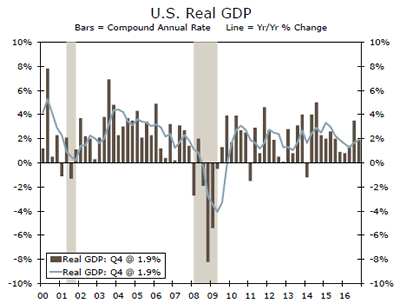
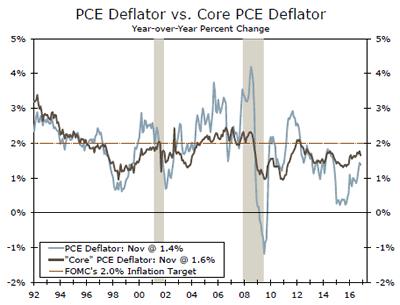
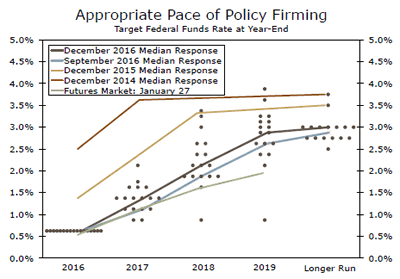
Credit Market Insights
Beige Book
Credit conditions across the country remained stable or strengthened, according to the Fed’s January Beige Book report. The Federal Reserve bank of San Francisco reported that while liquidity remains ample at the moment, that burdensome regulatory costs could constrain profitability moving forward. The reserve bank of New York highlighted the fact that credit conditions in retail and wholesale remain in good shape. It also noted that bankers in their region reported unchanging credit standards across all loan categories and lower delinquency rates for commercial mortgages and C&I loans.
The reserve banks of Cleveland, Chicago, Kansas City, Dallas and Richmond also reported strong credit quality conditions with little change in loan-application standards. The Federal Reserve Bank of Philadelphia reported a significant increase in credit card volumes for the recent holiday period, much larger than in 2016 and 2015.
Credit conditions within the St. Louis district improved at a moderate pace and overall lending experienced healthy growth across all lending categories. Increases in real estate lending made the largest contributions to total loan growth. Some banks reported increases in nonperforming loans in their agricultural loan portfolios, which they attribute to low commodity prices throughout last year. Firms across the country were said to be optimistic about growth in 2017.
Topic of the Week
Parliament Must Approve Brexit
There has been a question running through British politics ever since the Brexit referendum last June. Namely, could Prime Minister May unilaterally invoke Article 50 of the Lisbon Treaty, thereby setting in process negotiations between the United Kingdom and the European Union over terms of their divorce, or would Parliament need to give its assent? The U.K. Supreme Court weighed in this week, and by a margin of 8-3 said that Parliament would need to give its approval to trigger Article 50.
The decision means that Article 50 may not be triggered by the end of May as Prime Minister May had previously stated would occur. The elaborate procedure of debate and parliamentary tactics in both the House of Commons and the House of Lords inevitably will produce delay. In our view, however, Parliament will eventually trigger Article 50, which will mark the formal beginning of the Brexit process. Two-thirds of the voting precincts in the country voted in favor of Brexit on June23. Members of Parliament who represent these precincts would be committing political suicide if they voted against approval.
There are deep financial and economic ties between the UK and the other 27 members of the EU. The EU accounts for one-half of the U.K.’s trade (top chart), London is the financial capital of Europe, and the list goes on and on. Negotiating the new terms under which these economic and financial interactions will occur in the future will be a long and laborious process that is bound to create some uncertainty.
As noted on page 4, the Brexit referendum has had little visible effects on the British economy, at least so far. That said, stated investment intentions by businesses, which has a fair degree of correlation with actual investment spending, remains weak (bottom chart). The British economy could slow more sharply once the Brexit negotiations get underway. Stay tuned.
